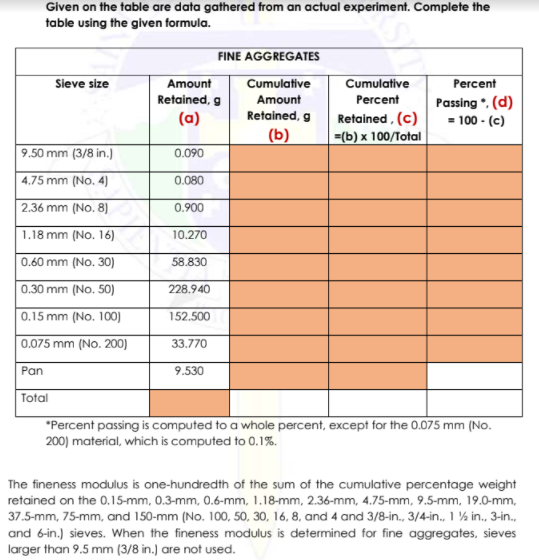Given on the table are data gathered from an actual experiment. Complete the table using the given formula. Solve the following problem in a completely and clearly solution. All answers (including the final answer) must be rounded to four decimal places.
Given on the table are data gathered from an actual experiment. Complete the table using the given formula. Solve the following problem in a completely and clearly solution. All answers (including the final answer) must be rounded to four decimal places.
Chapter2: Loads On Structures
Section: Chapter Questions
Problem 1P
Related questions
Question
100%
Given on the table are data gathered from an actual experiment. Complete the table using the given formula. Solve the following problem in a completely and clearly solution. All answers (including the final answer) must be rounded to four decimal places.

Transcribed Image Text:Given on the table are data gathered from an actual experiment. Complete the
table using the given formula.
FINE AGGREGATES
Sieve size
Amount
Cumulative
Cumulative
Percent
Passing •, (d)
= 100 - (c)
Retained, g
Amount
Percent
Retained, g
Retained, (c)
-b) х 100/olal
(a)
(b)
9.50 mm (3/8 in.)
0.090
4.75 mm (No. 4)
0.080
2.36 mm (No. 8)
0.900
1.18 mm (No. 16)
10.270
0.60 mm (No. 30)
58.830
0.30 mm (No. 50)
228.940
0.15 mm (No. 100)
152.500
0.075 mm (No. 200)
33.770
Pan
9.530
Total
*Percent passing is computed to a whole percent, except for the 0.075 mm (No.
200) material, which is computed to 0.1%.
The fineness modulus is one-hundredth of the sum of the cumulative percentage weight
retained on the 0.15-mm, 0.3-mm, 0.6-mm, 1.18-mm, 2.36-mm, 4.75-mm, 9.5-mm, 19.0-mm,
37.5-mm, 75-mm, and 150-mm (No. 100, 50, 30, 16, 8, and 4 and 3/8-in., 3/4-in., 1 ½ in., 3-in.,
and 6-in.) sieves. When the fineness modulus is determined for fine aggregates, sieves
larger than 9.5 mm (3/8 in.) are not used.
Expert Solution
This question has been solved!
Explore an expertly crafted, step-by-step solution for a thorough understanding of key concepts.
Step by step
Solved in 2 steps with 1 images

Knowledge Booster
Learn more about
Need a deep-dive on the concept behind this application? Look no further. Learn more about this topic, civil-engineering and related others by exploring similar questions and additional content below.Recommended textbooks for you


Structural Analysis (10th Edition)
Civil Engineering
ISBN:
9780134610672
Author:
Russell C. Hibbeler
Publisher:
PEARSON

Principles of Foundation Engineering (MindTap Cou…
Civil Engineering
ISBN:
9781337705028
Author:
Braja M. Das, Nagaratnam Sivakugan
Publisher:
Cengage Learning


Structural Analysis (10th Edition)
Civil Engineering
ISBN:
9780134610672
Author:
Russell C. Hibbeler
Publisher:
PEARSON

Principles of Foundation Engineering (MindTap Cou…
Civil Engineering
ISBN:
9781337705028
Author:
Braja M. Das, Nagaratnam Sivakugan
Publisher:
Cengage Learning

Fundamentals of Structural Analysis
Civil Engineering
ISBN:
9780073398006
Author:
Kenneth M. Leet Emeritus, Chia-Ming Uang, Joel Lanning
Publisher:
McGraw-Hill Education


Traffic and Highway Engineering
Civil Engineering
ISBN:
9781305156241
Author:
Garber, Nicholas J.
Publisher:
Cengage Learning